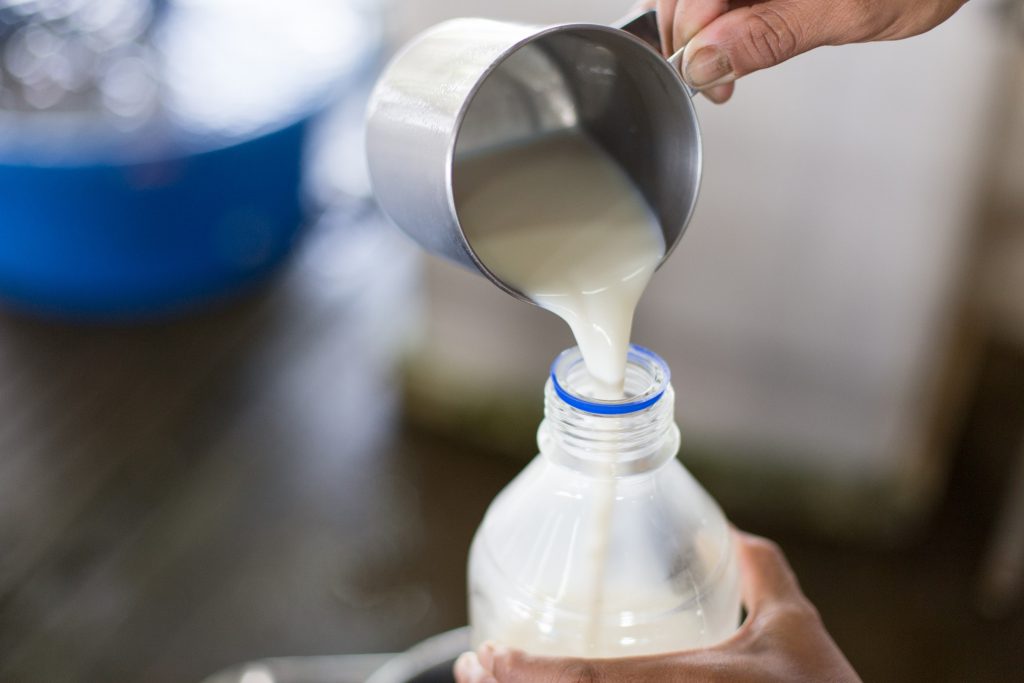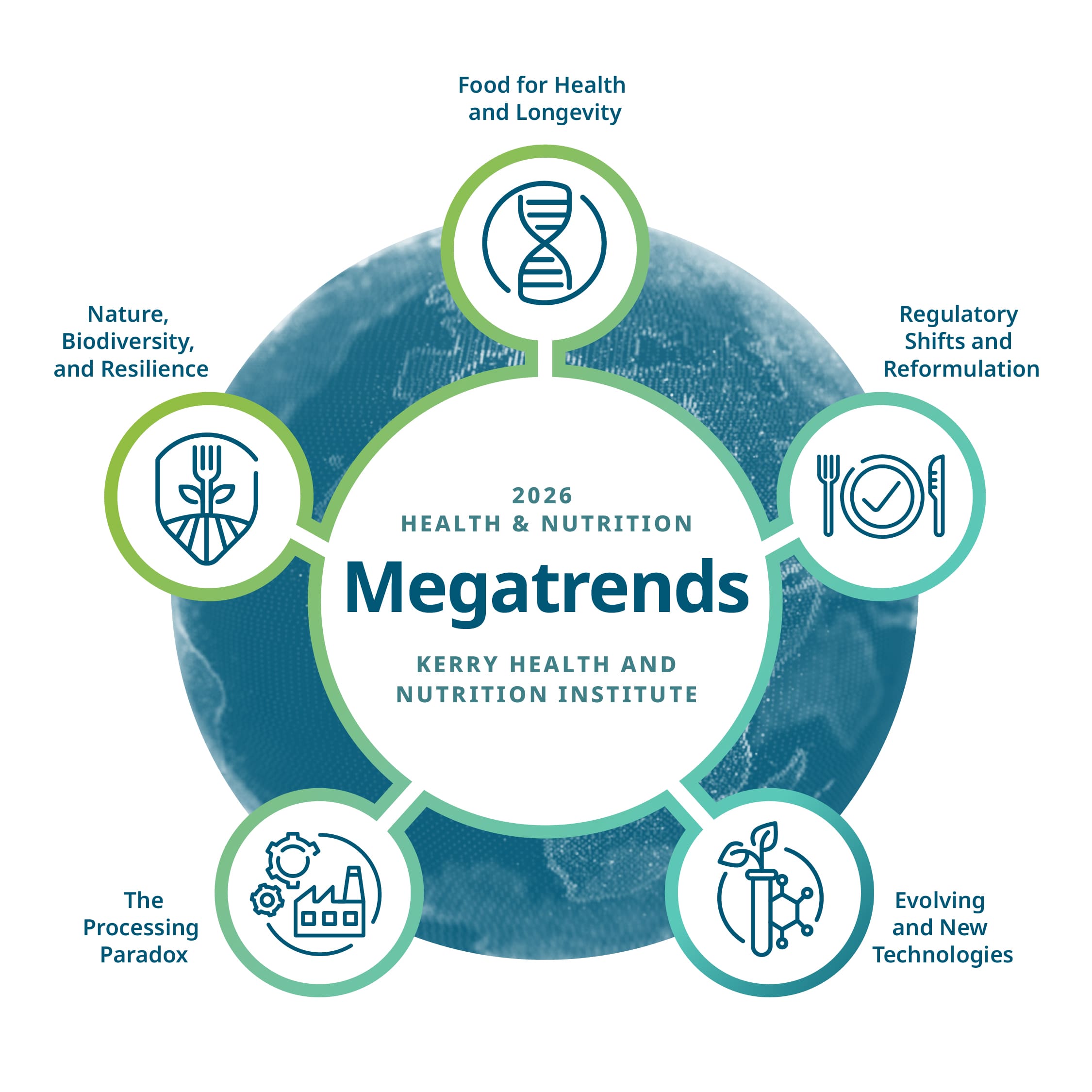Dairy products from grass-fed cows are in growing demand among today’s consumers, driven mostly by perceived health benefits and animal welfare concerns.1 This prompts the question: Are dairy products from grass-fed cows really better for us?
Scientists at Teagasc Moorepark Research Centre, Cork and the APC Microbiome Institute, University College Cork have explored this and found that grass-fed dairy has several nutrition advantages. They carried out a thorough study which demonstrates the many advantages that dairy produced from pasture-fed cows holds over those derived from their indoor counterparts, from both a compositional and nutritional perspective. This study compared milk derived from cows fed different diets, namely (i) grazed grass (outdoor), (ii) grazed grass plus clover (outdoor) or (iii) an indoor total mixed ration (TMR) diet.3 The TMR diet was primarily composed of maize, soybean meal, barley, and beet pulp.

Findings
Better raw materials for cheese-makers
Results showed that milk derived from grazing-based systems had significantly higher fat and protein (both casein and whey) yield and improved protein quality when compared with milk derived from cows fed a TMR diet. This provides a benefit to milk and cheese manufacturers because increased protein and casein concentration enhances cheese-making properties.3
Better nutrient profile for human health
Non-communicable diseases account for 65% of today’s deaths worldwide, of which diet and obesity play a major role, with cardiovascular disease (CVD) being the leading cause of early death and diabetes being another main cause.2 It is, therefore, not surprising that there is a growing interest amongst consumers in altering their diet to help reduce the risk or slow the progression of chronic diseases.1 Grass-fed dairy is proving to be a strong contender in this space.
Conjugated Linoleic Acid (CLA)
The study carried out by Teagasc indicates that pasture-based systems can improve the nutritional status of milk in a number of ways. The first is that pasture feeding increased the amount of conjugated linoleic acid (CLA) levels greater than two-fold compared to the TMR-fed cows. In particular the health enhancing isomer, cis-9,trans-11 CLA, was increased. CLA is unique among fatty acids in that the primary source is from ruminant animals, since the bacteria in the digestive tract of these animals are responsible for its production. There’s an emerging body of evidence that CLA confers a number of health benefits, including links to weight loss and reduced cardiovascular and metabolic disease risks.3 It’s not yet known exactly how CLA confers these benefits, but this is a growing area of discovery.

Omega-6/Omega-3 Ratio
|
Get KHNI articles delivered to your inbox
|
Feeding of a pasture-based diet also beneficially alters the omega-6 and omega-3 fatty acid ratio in cow’s milk, as observed by numerous studies around the world, which will be referred to below. Omega-6 and omega-3 polyunsaturated fatty acids (PUFAs) are essential fatty acids that must be derived from the diet as they cannot be produced by humans and other mammals. The last three decades have seen an increase in the consumption of omega-6 PUFAs and a drop in omega-3 PUFA intake in the Western world.4 This favour towards omega-6 PUFAs has resulted in an unbalanced omega-6/omega-3 ratio with a significant increase to as high as 20:1 today. Some proponents of this ratio believe, and some scientific evidence shows, a 1:1 ratio is optimal4,5, although this has not been proven. However, evidence shows the health benefits of increasing intake of omega-3 fatty acids, which is reflected in many global dietary recommendations to increase seafood consumption.
Modern grain and TMR feeding of farm animals is effective for production, but has contributed in-part to the omega-3 decrease and omega-6 increase in Western diets.1 Results from the current study showed that milk from pasture-based systems has significantly higher levels of omega-3 PUFAs (about a 70% increase) and significantly lower contents of omega-6 PUFAs than that of TMR milk. Another similar study in the US also observed this improvement in fatty acid profile in grass-fed dairy products and further noted a positive shift in the omega-6 and omega-3 ratio, bringing this ratio closer to the desired 1:1, compared to 5.7:1 in conventional whole milk. Furthermore, this study found that grass-fed milk contains 147% more omega-3 fatty acids than conventional dairy milk.1,6
Vitamin Boost
Another desirable health benefit observed in the Teagasc study, was an increase in certain vitamin levels. Milk derived from grazing-based systems had higher levels of vitamins B2, B7 and E. These vitamins are understood to have beneficial roles in the diet. Vitamin B2 and vitamin E act as powerful antioxidants, for example7,8 Both vitamin B2 and B7 are water soluble, and, thus are regularly diminished and need to be replenished in the diet.9

Ethical and Animal Welfare Claims
According to Bord Bia, the Irish Food Board, consumers want foods that are more natural, less processed and made with familiar ingredients, with a focus on greater transparency.9 The perception that grass-fed cows are living in a more natural environment is often linked to the quality of milk produced. Consumers believe grass-fed dairy is a premium, natural and environmentally friendly product. Two-thirds or more of consumers in European markets now show interest in grass-fed dairy, with the perception of natural being one of the major drivers for the use of pasture-based systems.10,11
What is the Future of Grass-fed Dairy?
In Ireland, grass from grazing pasture land has always been an important source of feed for dairy cows. However, grazing pasture-based systems are utilised by only 10% of milk production facilities across the globe.3 Therefore grass-fed dairy milk is not currently a mass market product. However, Mintel reports that it represents an area of growth within the dairy milk market.11 Public belief of improved environmental and animal welfare issues associated with grazing appears to be the main driver behind this growing demand for grass-fed dairy and beef.
There are restrictions which may inhibit or delay the expansion of pasture-based systems in some parts of the world, such as insufficient land for increased pasture feed requirements, but this has not restricted the growth of demand in these regions. For example, imports of grass-finished beef to the US from Australia largely surpass the domestic US grass-finished beef supply. The grass-fed beef market is growing at a rapid rate of 20%-35% per year in the US and is encouraging US suppliers to consider shifting domestic production to grass-finished beef.12
So: are grass-fed dairy products really better for us? Data from this study and a growing body of additional studies suggest the answer is yes. The benefits of grass-fed dairy extend beyond enhanced protein quality and quantity, the improved nutritional profile may in fact also improve human health. Consumers are increasingly exploring diet alterations as an aid to help reduce disease risks or to slow their progression. Pasture-based systems offer a unique solution in this space for these health-conscious consumers as well as for farmers looking to expand with this new growing demand.
Contributor:
-
References
- Benbrook C. M., Davis D. R., Heins B. J., Latif M. A., Leifert C., Peterman L., Baranski, M. Enhancing the fatty acid profile of milk through forage-based rations, with nutrition modeling of diet outcomes. (2018). Food science & nutrition, 6(3), 681–700. https://www.ncbi.nlm.nih.gov/pmc/articles/PMC5980250/
- Gakidou E., Afshin A., Abajobir A. A., Abate K. H., Abbafati C., Abbas K. M., & Abu-Raddad L. J. Global, regional, and national comparative risk assessment of 84 behavioural, environmental and occupational, and metabolic risks or clusters of risks, 1990–2016: a systematic analysis for the Global Burden of Disease Study 2016. (2017). The Lancet, 390(10100), 1345-1422. https://www.thelancet.com/pdfs/journals/lancet/PIIS0140-6736(17)32366-8.pdf
- Green pastures deliver superior dairy products. (2016). Teagasc News. https://www.teagasc.ie/news–events/news/2016/green-pastures.php
- Grass fed dairy cows produce milk with superior nutritional properties. (2018). Teagasc News. https://www.teagasc.ie/news–events/news/2018/grass-fed-dairy-cows-prod.php
- O’Callaghan T. F., Hennessy D., McAuliffe S., Kilcawley K. N., O’Donovan M., Dillon P., Stanton C. Effect of pasture versus indoor feeding systems on raw milk composition and quality over an entire lactation. (2016). Journal of dairy science, 99(12), 9424-9440. https://www.journalofdairyscience.org/article/S0022-0302(16)30667-1/fulltext
- Simopoulos A. P. An Increase in the Omega-6/Omega-3 Fatty Acid Ratio Increases the Risk for Obesity. (2016). Nutrients, 8(3), 128. https://www.ncbi.nlm.nih.gov/pmc/articles/PMC4808858/
- Simopoulos A. P. The Importance of the Omega-6/Omega-3 Fatty Acid Ratio in Cardiovascular Disease and Other Chronic Diseases. (2008). Experimental Biology and Medicine, 233(6), 674–688). https://www.ncbi.nlm.nih.gov/pubmed/18408140
- Mintel: Dairy and Non-Dairy Milk, US September 2018
- Ashoori M., Saedisomeolia A. Riboflavin (vitamin B 2) and oxidative stress: a review. (2014). British Journal of Nutrition, 111(11), 1985-1991. https://www.ncbi.nlm.nih.gov/pubmed/24650639
- Rizvi S., Raza S. T., Ahmed F., Ahmad A., Abbas S., Mahdi F. The role of vitamin e in human health and some diseases. (2014). Sultan Qaboos University medical journal, 14(2), e157–e165. https://www.ncbi.nlm.nih.gov/pmc/articles/PMC3997530/
- Hemmati M., Babaei H., Abdolsalehei M. Survey of the effect of biotin on glycemic control and plasma lipid concentrations in type 1 diabetic patients in kermanshah in iran (2008-2009). (2013). Oman medical journal, 28(3), 195–198. https://www.ncbi.nlm.nih.gov/pmc/articles/PMC3679599/
- Bord Bia: Growing the success of Irish food & horticulture – Grass Fed Dairy. https://www.teagasc.ie/media/website/publications/2018/Grass-Fed-Dairy—Mary-Morrissey—National-Dairy-Conference-2018.pdf
- Mintel: Dairy and Non-Dairy Milk, US September 2018
- Hayek M. N., & Garrett R. D. Nationwide shift to grass-fed beef requires larger cows population. (2018). Environmental Research Letters, 13(8), 084005. https://www.researchgate.net/profile/Matthew_Hayek/publication/326451403_Nationwide_shift_to_grass-fed_beef_requires_larger_cows_population/links/5b5cb6460f7e9bc79a6c4906/Nationwide-shift-to-grass-fed-beef-requires-larger-cows-population.pdf?origin=publication_detail
- F. O’Callaghan, D. Hennessy, S. McAuliffe, D. Sheehan, K. Kilcawley, P. Dillon, R.P. Ross, and C. Stanton. The effect of cow feeding system on the composition and quality of milk and dairy products. Proceedings of the Grass-Fed Dairy Conference Naas, Co. Kildare, Ireland 25th of October 2018

 Niamh Hunt, PhD, joined Kerry Taste & Nutrition in March 2019 as marketing analyst for the Applied Health & Nutrition team. Niamh graduated from Dublin City University with a PhD in Immunology, where she specialised in protein hydrolysates for immune health. Niamh has brought her interest in nutrition and health to her current role, supporting the Applied Health & Nutrition marketing team globally.
Niamh Hunt, PhD, joined Kerry Taste & Nutrition in March 2019 as marketing analyst for the Applied Health & Nutrition team. Niamh graduated from Dublin City University with a PhD in Immunology, where she specialised in protein hydrolysates for immune health. Niamh has brought her interest in nutrition and health to her current role, supporting the Applied Health & Nutrition marketing team globally. 

